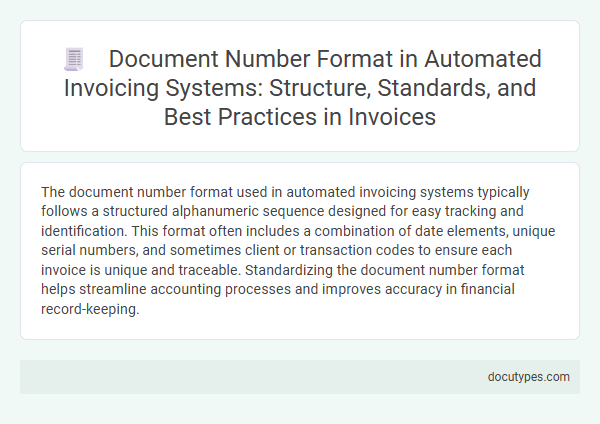The document number format used in automated invoicing systems typically follows a structured alphanumeric sequence designed for easy tracking and identification. This format often includes a combination of date elements, unique serial numbers, and sometimes client or transaction codes to ensure each invoice is unique and traceable. Standardizing the document number format helps streamline accounting processes and improves accuracy in financial record-keeping.
Introduction to Document Number Formats in Automated Invoicing
Automated invoicing systems use specific document number formats to uniquely identify each invoice. These formats typically include a combination of letters, numbers, and sometimes dates to ensure accurate tracking and retrieval. Understanding the structure of your document number format is essential for efficient invoice management and compliance.
Importance of Structured Numbering in Invoice Management
The document number format used in automated invoicing systems typically follows a structured combination of alphanumeric characters that represent key information such as date, client ID, and invoice sequence. Structured numbering ensures each invoice is unique, easily traceable, and compliant with accounting regulations. This organization enhances invoice management by simplifying audit processes, improving retrieval efficiency, and reducing errors in financial records.
Common Document Numbering Standards in Automated Systems
The document number format used in automated invoicing systems typically follows standardized conventions to ensure consistency and traceability. Common formats include alphanumeric codes that incorporate date, branch, and sequential numbering elements.
Popular standards often use formats like YYYYMMDD-XXX or INV-YYMM-0001 for easy identification and sorting. Your system's document numbering should align with these standards to enhance accuracy and streamline invoice management.
Key Components of an Invoice Document Number
| Key Components of an Invoice Document Number | Description |
|---|---|
| Prefix | A short alphanumeric code representing the company or department issuing the invoice. This helps in rapid identification and categorization. |
| Date Code | Incorporates the invoice creation date in formats such as YYYYMMDD or YYMMDD, ensuring chronological tracking within automated invoicing systems. |
| Sequential Number | A unique number incrementing with each invoice to guarantee uniqueness and prevent duplicates. Sequential numbering enhances traceability and audit compliance. |
| Check Digit or Control Character | An optional element used for error detection, confirming the integrity of the invoice number during data entry or transmission. |
| Separator Characters | Dashes, slashes, or underscores used to visually separate components of the document number, improving readability and data parsing. |
Your automated invoicing system's document number format combines these key parts to create a structured, easily trackable identifier essential for efficient financial management and compliance.
Sequential vs. Custom Numbering Approaches
What is the document number format used in automated invoicing systems? Automated invoicing systems typically use either sequential or custom numbering approaches to organize invoice identification. Sequential numbering assigns numbers in a continuous order, ensuring easy tracking and chronological consistency.
How does custom numbering differ from sequential numbering in invoicing? Custom numbering allows businesses to incorporate specific codes or prefixes related to departments, dates, or projects in their invoice numbers. This approach increases flexibility and provides more detailed information within each document number.
Compliance and Regulatory Considerations for Number Formats
The document number format used in automated invoicing systems typically follows a structured alphanumeric sequence designed to ensure uniqueness and traceability. Compliance with local tax authorities and regulatory frameworks requires these formats to adhere to specific patterns, including date codes, sequential numbering, and company identifiers.
Regulatory bodies often mandate the inclusion of fiscal year indicators or branch codes within the invoice number to facilitate audits and prevent duplication. Automated systems must generate document numbers that are immutable and chronologically ordered to maintain compliance with laws such as the EU VAT Directive or IRS regulations in the United States. Failure to align with these standards risks penalties and invalidation of the invoice for tax deduction purposes.
Best Practices for Designing Robust Numbering Schemes
Automated invoicing systems utilize document number formats that ensure uniqueness and traceability for each invoice. These formats often combine alphanumeric characters with date and sequence elements to prevent duplication and facilitate easy tracking.
Best practices for designing robust numbering schemes include incorporating a prefix that identifies the invoice type and embedding the issue date in a standardized format. Sequential numbering should be consistent and reset periodically to maintain order while avoiding overlaps across different billing cycles.
Avoiding Duplicates and Ensuring Traceability
The document number format in automated invoicing systems is designed to avoid duplicates and ensure traceability by incorporating unique identifiers. This format typically combines date, sequence, and alphanumeric codes to maintain accuracy and track transaction history.
- Unique Sequence Numbers - Automated invoicing systems use incrementing or randomized sequence numbers to prevent duplicate document IDs.
- Date Stamping - Including date information within the document number aids in chronological organization and traceability.
- Alphanumeric Codes - Mixing letters and numbers enhances the complexity of invoice numbers, reducing the risk of duplication and improving identification.
Integrating Document Numbering with ERP and Accounting Software
The document number format in automated invoicing systems is designed to ensure unique and traceable identifiers for each invoice. This format integrates seamlessly with ERP and accounting software to maintain consistency across financial records.
- Standardized Alphanumeric Codes - These codes combine letters and numbers to create structured and easily sortable invoice numbers.
- Sequential Numbering Integration - The system assigns invoice numbers in a sequential order that corresponds with your ERP's transaction history.
- Custom Prefix and Suffix Usage - ERP and accounting software allow adding date stamps or client-specific codes as prefixes or suffixes to enhance identification.
Integrating document numbering with ERP and accounting software improves accuracy and streamlines financial workflows.
What Is the Document Number Format Used in Automated Invoicing Systems? Infographic

